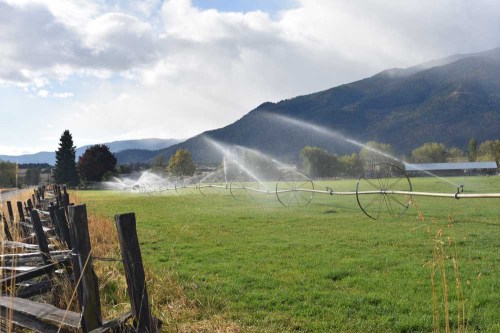Farmers, ranchers adjusted quickly to pandemic
Published 10:48 am Thursday, October 15, 2020

- The COVID-19 pandemic has affected all aspects of society, but farmers and ranchers have continued their customary work throughout. This wheel line was watering a pasture in Baker Valley near the base of the Elkhorn Mountains in early October.
BAKER CITY — Social distancing is pretty easy when you’re alone in the cab of a tractor.
No industry is immune to the effects of the coronavirus pandemic, certainly.
Trending
But Mark Coomer said that for his farmer and rancher clients in Baker County, 2020, despite its upheavals, has in some respects been a typical year.
Against the backdrop of new daily cases and mask mandates and canceled events, the basics of the agriculture business, which generates more than $80 million in annual sales in the county, were unchanged.
Fields to plow.
Sprinklers to move.
Crops to harvest.
Cattle to drive between pastures.
Trending
“I think people are tired of it, they want it to be over, but they’ve realized it’s not the shock they anticipated,” said Coomer, branch manager at the Baker City office of Northwest Farm Credit Services.
“We actually expect agriculture to be reasonably profitable this year in spite of the COVID outbreak.”
Coomer said his clients in general were more worried last spring, early in the pandemic.
Businesses were closing due to government-mandated restrictions, including, most distressingly for farmers and ranchers, many of the restaurants that buy their products.
Commodity markets were volatile.
Beef processing plants shut down temporarily due to virus outbreaks, leaving ranchers to wonder whether they could sell their cattle, and if so whether they would break even on the deal.
But as summer arrived, with crops ripening and calves fattening, the overall situation became stable, Coomer said, at least as compared to what it was in March and April.
The Trump administration declared meatpacking plants as essential businesses, and as they reopened, the backlog in beef and other protein markets gradually shrank.
Some restaurants reopened, albeit with limitations, and Coomer said the demand for beef from the retail and grocery sectors replaced the restaurant and food service sectors at a higher level than many producers expected.
And federal financial aid programs, through the CARES Act that Congress passed and President Trump signed in late March, “has done pretty good at filling in some of the gaps,” Coomer said.
“On the whole we’ve weathered it pretty well,” he said. “There’s some optimism. But farmers and ranchers are always optimistic, or they wouldn’t be farmers and ranchers.”
Coomer said some of the factors that have benefited agricultural producers during the pandemic apply generally to the industry.
“People have to eat,” he said. “If you’re producing food and fiber, that’s going to be in demand no matter what. Agriculture is pretty much an essential industry.”
But other factors were either coincidental, or not applicable everywhere.
The timing of the pandemic, for instance, belongs to the former category.
Because it started in March, most producers had already planned their 2020 schedule, and they didn’t have to worry about marketing their products for several months, meaning there was time for the situation to calm.
As, indeed, it did, Coomer said.
The pandemic’s effects were curbed in Baker County and other parts of Eastern Oregon because farmers and ranchers don’t rely as much, if at all, on seasonal workers from outside the area, as is the case with, for instance, orchard owners, Coomer said.
Producers that provide housing for harvest employees had to spend more money than usual to make sure COVID-19 precautions were in place, he said.
But in Baker County most operators had a normal season, one exception being a minor shift in potato harvests to ensure adequate distance between workers who stand beside conveyor belts and toss out inferior spuds before they tumble into the storage cellar.
Coomer said most of his clients told him the pandemic hasn’t greatly affected their regular summer routines.
“Most said they don’t go to town much anyway,” he said. “It’s just not that hard to socially distance when you’re farming. And there’s not a lot of indoor activity. They just got the crops in as usual.”
Coomer said growing conditions were good with a few exceptions, including some hail damage.
The spring was sufficiently damp to nourish newly planted crops, but temperatures weren’t cold enough, as they often are in Baker County, to stunt plants’ growth, he said.
Summer was drier than usual — Oregon Gov. Kate Brown declared a drought emergency for Baker County on Sept. 15 — but Coomer said reservoirs supplied adequate irrigation water in most cases for landowners with rights to that water.
“Across the board my customers had really good yields, good quality,” he said. “We had really good conditions in the spring for grasses and grains. And crops were far enough along to withstand the dry summer.”
Coomer said he’s been impressed by the creativity some producers have shown in adjusting to the unexpected, and unprecedented, effects on commodity markets.
He said one rancher client decided to sell beef directly to local residents, offering them a free chest freezer if they bought beef. The idea is that a person who has a freezer is likely to keep buying a year’s worth of beef and take advantage of the discount in buying in volume.
“There’s some innovation that has come out of (the pandemic),” Coomer said. “The ingenuity of American business is really remarkable.”
Curtis Martin, a cattle rancher near North Powder and a former president of the Oregon Cattlemen’s Association, said the pandemic, and the temporary beef shortages at some grocery stores that resulted, highlighted what he believes is a need to decentralize America’s meatpacking industry.
That industry is dominated by a handful of massive corporations, and Martin thinks the future trend will be to have regional processing plants that can handle between 25 and 200 cattle per day rather than thousands.
Martin believes that change would give ranchers in remote areas, such as Eastern Oregon, a more direct role in the marketing of their animals.
He also endorses the direct marketing ideas that Coomer mentioned, which allow customers to buy beef that was raised in some cases just a few miles from their homes.
“I see that as a very viable option, it’s a great choice,” Martin said.
Looking ahead
Although 2020 was hardly a disaster for the agriculture industry, as might have seemed possible if not probable in early spring, Coomer said producers still have legitimate concerns.
Export markets, which are vital for many Oregon farmers and ranchers, are soft, and it’s unclear how the continuing pandemic will affect those markets, he said.
The Nov. 3 election could affect commodity markets and, depending on the outcome, lead to changes in tax policy and other areas that directly affect agriculture.
And the drought means irrigation water could be scarce in 2021 unless the coming winter brings a bountiful snowpack to the mountains, the region’s most important, and largest, reservoir.
“There’s a lot of issues that will be bigger than the coronavirus (in their potential effects on agriculture),” Coomer said.
“People have to eat. If you’re producing food and fiber, that’s going to be in demand no matter what. Agriculture is pretty much an essential industry.”
— Mark Coomer, Northwest Farm Credit Services









